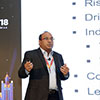Andhra Pradesh is a state that does things in a bigger way. This state is a true inspiration for the entire nation. ICT Academy is not exceptional; the thrust from one of the colleges of Andhra Pradesh has made ICT Academy to expand its focus from faculty training to student training. ICT Academy was started with a vision to connect industry and academia in terms of knowledge sharing and skill development. In this process, around 800 higher educational institutions are associated with ICT Academy already; where,
ICT Academy partners with major tech giants to get support in terms of technology sharing and content for the skill development of the faculty members and students. ICT Academy acts a bridge between industry and academia. This Conference is one such initiative to connect industry and academia that gathers policy makers, industry, and academia to empower thousands of faculty members across India, with intent to empower them as the agents of change in fostering India for Industry 4.0.

CA V Pattabhi Ram
Partner
Yoganandh & Ram
There are some great and unique personalities like Dr. APJ Abdul Kalam, Satya Nadella, Sundar Pichai, etc., we may not get a chance to interact and learn from such unique personalities, but we have an opportunity to peek into the mind of outstanding people in the world through the books written about them.
Here, I present such 6 great books in this forum.
Book 1 – ‘To Sir, With Love’ is an autobiographical novel by E. R. Braithwaite. The book celebrate teachers and beauty of the book lies in the portrayal of relationship between a teacher and his students.
Book 2 – ‘The Elephant and the Dragon’ written by Robyn Meredith. It’s a fascinating read, and challenges us to take more seriously the way developments happening in China and India will affect the nature and quality of our lives in the years to come.
Book 3 – ‘The Citadel’ is a novel by A. J. Cronin. Based on Cronin’s own experiences as a physician, The Citadel boldly confronts traditional medical ethics, and has been noted as one of the inspirations for the formation of the National Health Service.
Book 4 – ‘The Wealth of Nations’ by Adam Smith. This book is the foundation of modern economic thought and remains the single most important account of the rise of, and the principles behind, modern capitalism.
Book 5 – ‘The Driver in the Driverless Car’. A book on how our technology choices will create the future. The author offers three questions to ask about every emerging technology: Does it have the potential to benefit everyone equally? What are its risks and rewards? And does it promote autonomy or dependence?
Book 6 –‘Freedom at Midnight’ by Dominique Lapierre and Larry Collins. The saga of the Indian subcontinent’s independence from Britain and the creation of the states of India and Pakistan told through a collection of interrelated stories about major events and important figures that influenced the independence movement.

Prateek Parashar
Director - Utilities Cloud Program
Oracle
We stand on the brink of a technological revolution that will fundamentally alter the way we’ll live, work and communicate with each other. India being the second most populous country in the world, having more than 50% of its population in the age range of 27, should aspire to play a pivotal role in shaping the global agenda in a responsible, scalable and inclusive manner.
Based on the past 150 years of data compiled, economists say that technology has created more jobs than it destroyed. They say that, growth of jobs in the creative and tech industries will be much higher than the loss of jobs in agriculture and manufacturing sectors.
Therefore, the jobs are not dying, they are evolving. Low skill - low wage jobs and high skill - high wages jobs are going to stay, but the jobs at midlevel are expected to disappear. Economists call this pattern as job polarization.It’s a situation where a pattern is skewed towards the polar end and the center becomes hollow.
In this kind of transition, it is generally seen that the people are not able to catch up with the newer technologies and their skills do not move to the bracket of high skills and high wages; as a result, they fall into the bracket of low skill and low wages. This trend increases the supply of human resources for the low wages and the unchanging demands for the lowest skill and low wages bracket, forces wages to go down further. Hence, if we want to keep moving forward in the high skill high wages section, we need to keep learning new skills and keep reinventing ourselves.

Dheeraj Baijal
Director
Presales & Strategic Engagements
TCS
While the Industry 4.0 is focused on smart, intelligent and selfdriven environment, there are few challenges, which hinder the corporate to align with industry 4.0.
The major challenges are interoperability – how the machines of different brand and organizations work in a smooth environment, quick decision making – as the product life cycle has been reduced from years to months, productivity, safe and smart workplace for employees and adapting to automation. The technologies that drive the transformation journey of Industry 4.0 are smart sensors, Additive Manufacturing, Big Data Analytics, Cloud Computing, Augmented Reality, Automated Systems and Artificial Intelligence.
From the TCS perspective, the key components of Industry 4.0 are cyber physical systems, digital threads, digital twins, and advanced manufacturing. With these technologies and challenges in place, students should be ready with the following future skills to standout in the 4.0 era; these skills include basic ICT knowledge, the ability to work with data, as Big Data plays a major role in the industry 4.0; technical know-how of skills to provide apt solutions and personal skills viz., ability to change, decision making, and working in team, communication skills and mindset for lifelong learning.

Narayana Birakayala
Business Development Capture Lead - India
Amazon Web Services
Cloud Computing is paving the way for innovation because it offers agility, disruptive innovation, new skills and cost saving which attracts the customer. Cloud Computing has set a new trend in various technologies like Serverless Computing, Micro Service Architecture, Green Screen Terminals and many more. Physical servers are now converted into serverless, virtual Cloud-based servers that are hardware independent and efficient. Micro Services Architecture has enhanced the structure of deployment in the system by decreasing the iteration timing in programing and code development. Green Screen Terminal has evolved itself from GUI to Mobile which has changed a machinecentric interface into a humancentric interface. Cloud literacy is as important as numeracy and literacy skills in which most featured technology infrastructure platform can be created.
AWS initiatives help students, academia and government to build a new skill set using these trending technologies. To enable students to learn Cloud technology skills, AWS Educate has initiated “Cloud Literacy Month” to induce self-learning and introduce basic Cloud technology skills to all students.
Apart from this, AWS has built many technology-enabled learning initiatives such as conducting workshops and events to provide students and educators the resources needed to accelerate Cloud-related learning.

Abhijit Rao
Head of Talent Acquisition - India & APAC
UiPath
Technology has evolved and changed human life in various ways in which we need to find a way to translate evolution into action that impacts the lives of people. Industry wants people to be self-enabled, autonomous and self-reliant.
In this new era of automation, RPA and AI play major role in building and progressing things. RPA is a type of software that mimics the activity of human beings in carrying out a specific process-based task. It can do repetitive stuff more quick, accurate and it is tireless than humans. Artificial intelligence (AI), sometimes called Machine Intelligence, is such intelligence demonstrated by machines, in contrast to the natural intelligence displayed by humans.
Many AI algorithms are capable of learning from data; they can enhance themselves by learning new heuristics. AI or RPA does not eliminate job, instead they create new jobs. From a business perspective, it is essential to improve the skills of the employees to this new trend so that they will perform faster and better at their jobs. RPA and AI career path includes Developers, Solution Architects, Infrastructure Engineers and Business Analysts.
UiPath is an organization which helps people to understand and adopt RPA. Programs like Ui Path Community Forum, Ui Path Academic Alliance Program help people to understand RPA and AI in an easy and better way. Ultimately, we need people to reskill and upskill to survive in the upcoming technology era.

Bharathan Prahalad
Assistant Vice President - Human Resources
FSS
Industry 4.0 is the evolution of industrialization of economies and now we are in the fourth phase of it. At every phase, it evolved better, improved production and the finesse of the quality of work. Economies are built by the people who understand the core value proposition they are bringing in. For example, Apple has User Interface as the core value proposition. Before 1997, the company believed itself as a core computer technology company, but after the appointment of Steve Jobs as CEO, he demonstrated clearly that Apple is User Interface Company and they are good at it. From that moment, the outlook of Apple changed, created new benchmarks and rest is history. Similarly, the core competency of educational institutions is the value that they create. It takes at least four decades for an educational institution to get recognized as the centre for value creation. Focusing on the value creation would make institutions self-sustainable in the long run. The next key resource for any business is Time, because everything is time bound. Eventually, it is the quality of the students that you create defines the quality of your institutions. If an institution could create 10 outstanding alumni in the next decade, then it has achieved its feat of being an outstanding centre of value creation. Therefore, if you think of value creation, think of valuable alumni creation.

Chandrasekhar Chenniappan
Senior Director – Human Resources
Virtusa
Advanced Analytics and Big Data, Internet of Things (IoT), Robotics and Automation, Artificial Intelligence and Process Digitization are the building blocks of Industry 4.0. India’s share on the industry 4.0 will be remarkable as predicted by major research organizations. By 2025, India will have 25% of global Big Data market which is estimated to be 1 lakh crore with this prediction, India has 1500+ in-house global technological centres, which would demand huge quantity of quality engineers in the future. So, educational institutions have to prepare their students to feed these growing demands. As a process, I recommend the faculty members to follow some basic steps to enable the students for industry 4.0.
- Create awareness midst students on Industry 4.0
- Academicians and students should have the willingness to change to the evolving methodologies in the industrial world.
- Third, shifting the focus from studying to learning
- Fostering the culture of innovation in the institutions
I’m sure that imparting the above said action points in the institutions will augment the nation’s transformation towards the future technology world.

Dattaraj Rao
Principal Architect
GE Transportation
Internet is touching everyone’s life through platforms like Amazon, Uber, Netflix etc., which is evidentially the result of a big revolution happening in the industrial world. Machines have become a part of man’s life. From aircrafts to locomotives, people expect smarter machines with better sensors and connectivity. These machines generate huge amount of information, which need new technology to manipulate it as a meaningful data that would help to develop new ideas and products. AI and Big Data play a major role in fetching data that would augment Machine Learning and Deep Learning. We start this process with Products as Asset and then plan it at the process level and finally put it across the network level. For locomotives we need high definition camera, GoLANG Data aggregator platform and 8TG storage expansion. We wanted a common platform and so we created a Vision Development of Analysis model on cloud which has single platform from data acquisition to action, optimized storage and VI Catalog for deep and machine learning.

Chandrashekar Chenniappan
Senior Director HR
Virtusa
From an academic point of view, the journey of industrial revolution starts from 1.0 to 4.0. India was a core consumer in the industry period 1.0 and 2.0 but India became contributors in the industry 3.0 and 4.0. The Five major building blocks of industry 4.0 are Advanced Analysis & Big Data, IoT & Services, Robotics & Automation, AI and Process Digitization. As an advantage, by 2020 India is expected to corner 20% of global IoT market, by 2025 India is expected to corner 32% of global Big Data market. These data points show the volume of opportunities lying in front of us. We have to channelize our efforts and put our focus on right things to build our future generation. Repeated and monotonous jobs will be automated which will in turn bring impact in Indian job sectors. We have to develop a flexible and open mind to learn new things for new future. We need to teach youth to focus on qualitative skills in their area and move forward without compromising fundamentals and foundation. Creating awareness, willingness to change, study to learn, and culture of innovation are the key aspects required to move forward in Industrial Revolution 4.0.

Vasuprada Murthy
Asia Pacific Services Leader
Watson Talent Management Solutions
IBM
IBM contributes to Industry 4.0 through its product called Watson, which is a cognitive capability machine. IBM is trying to solve the problem of Talent Management of various companies using the fourth generation AI technology. IBM aims to turn HR into a more reliable driver of business outcomes with AI-powered technology. According to WorkTrends global survey, recruiters spend a large portion of time searching for candidates and scanning resumes; yet organizations say they would not rehire 40% of recent hires. In such a scenario, Watson helps to find the right talent, faster, with insights fueled by AI. During the recruitment process, Watson assists to assess and measure talent to predict their performance. While more than 50% of organizations have difficulty retaining valued employee groups, with Watson’s AI technology, a company can engage and retain talent with personalized career development programs.With Watson tools for HR, companies are seeing a 64% increase in candidates who progress to a face-to-face interview, a 20% increase in average monthly hires by recruiters, and a 47% increase in candidates submitted per day from recruiters to hiring managers.